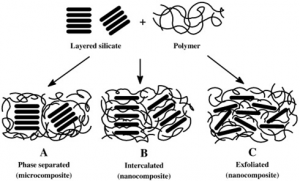Site Kategori Arşivi: bentonit
Montmorillonitin NanoKompozitlerde Antibakteriyel Özelliği
Yine yakın tarihli bir diğer araştırmada, gümüş iliştirilmiş modifiye yüksek dallı epoxy ve bentonit sentezi yapılmış bu sentezden oluşan birleşimin antibakteriyel özelliği incelenmiştir. Yapılan incelemelerde;
Montmorillonitli Gümüş bileşiminin, S.Aureus, Bacillus Subtilis, E.Coli, Pseudomonas A., K. Penumoniae ile ilişkileri gözlemlenmiş ve sonuçlar neticesinde bu nanokompozitin antimikrobiyal malzeme olarak kullanılabileceği ortaya konmuştur.
Çalışmanın İngilizce özetine aşağıda yer verilmiştir;
Silver-embedded Modified Hyperbranched Epoxy/Clay Nanocomposites As Antibacterial Materials.
Roy B, Bharali P, Konwar BK, Karak N.
Advanced Polymer and Nanomaterial Laboratory, Department of Chemical Sciences, Tezpur University, India
PMID: 23131638 [PUBMED – indexed for MEDLINE] Bioresour Technol. 2013 Jan;127:175-80
Silver-embedded modified hyperbranched epoxy/clay nanocomposites were prepared at different wt.% of octadecyl amine-modified montmorillonite at a constant silver concentration (1 wt.%).
 UV-visible, XRD and TEM studies confirmed the formation of silver nanoparticles. Compared to the system without silver and clay, the gloss from 70° to 94°, scratch hardness from 4 to 5.8 kg, impact strength from 60 to 90 cm, tensile strength from 8.5 to 15.5 MPa, adhesive strength from 5 to 7.1 × 10(9)N/m, flexibility from >6 to <4mm, and thermostability from 230 to 260 °C increased for the modified system. Resistance to aqueous 10% HCl, 0.5% NaOH, 10% NaCl also increased. The nanocomposites showed antibacterial activity in well diffusion assays against Staphylococcus aureus, Bacillus subtilis, Escherichia coli, Pseudomonas aeruginosa and Klebsiella pneumoniae. The results showed that these nanocomposites have potential to be used as antimicrobial materials.
UV-visible, XRD and TEM studies confirmed the formation of silver nanoparticles. Compared to the system without silver and clay, the gloss from 70° to 94°, scratch hardness from 4 to 5.8 kg, impact strength from 60 to 90 cm, tensile strength from 8.5 to 15.5 MPa, adhesive strength from 5 to 7.1 × 10(9)N/m, flexibility from >6 to <4mm, and thermostability from 230 to 260 °C increased for the modified system. Resistance to aqueous 10% HCl, 0.5% NaOH, 10% NaCl also increased. The nanocomposites showed antibacterial activity in well diffusion assays against Staphylococcus aureus, Bacillus subtilis, Escherichia coli, Pseudomonas aeruginosa and Klebsiella pneumoniae. The results showed that these nanocomposites have potential to be used as antimicrobial materials.
Bentonit Tedavisi Bentonit > bentonit > Sayfa 26








Bir Cevap Yazın